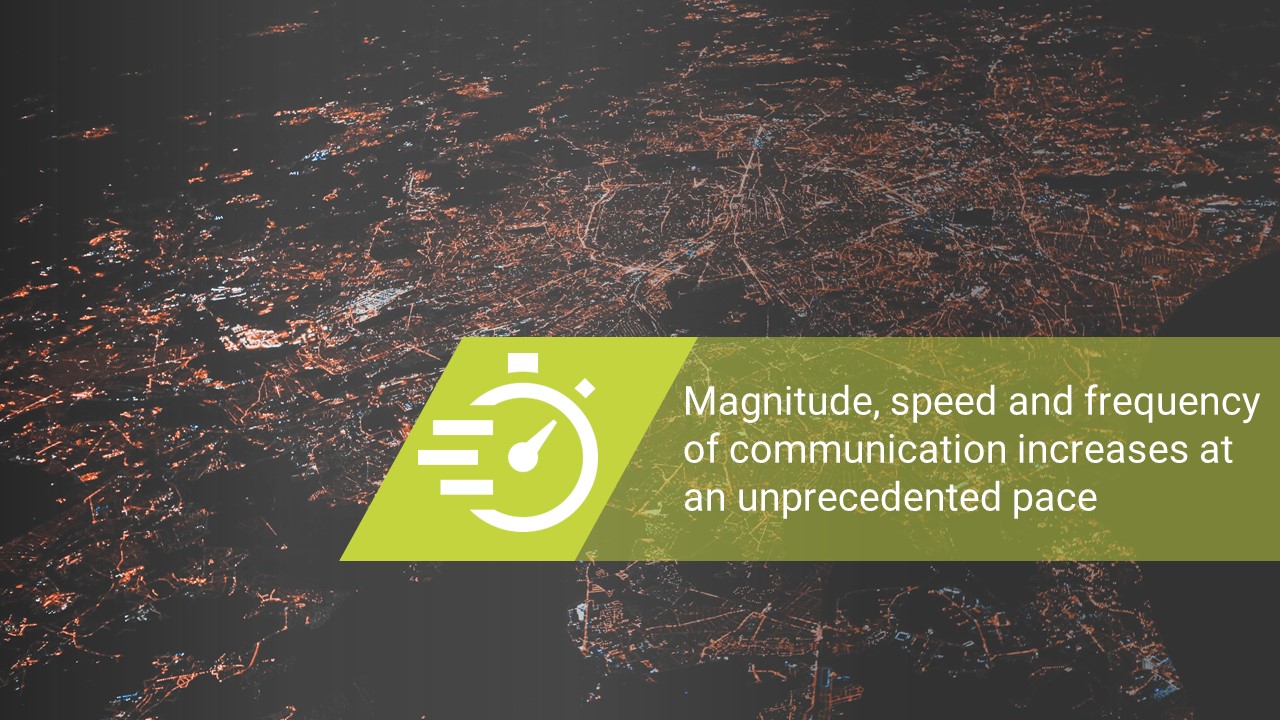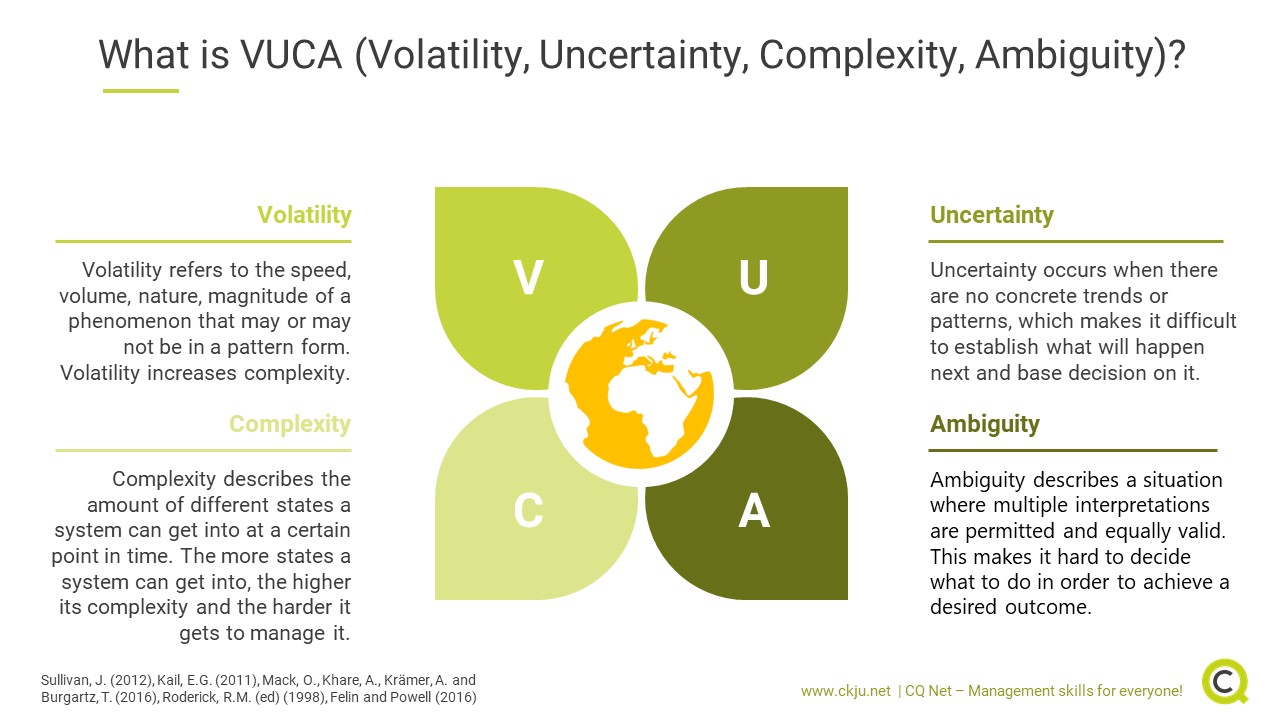- Blog
- Strategic management in a VUCA world
Contents
- Why VUCA? The pace of change increases
- Antifragility helps a perspective change: there is hidden potential in disorder
- What is VUCA and what is a VUCA world?
- Strategic management helps organizations to manage the dynamics of a VUCA world
- The benefits of transformational leadership in a VUCA world
- Adapting to change on an individual level helps organizational and strategic flexibility
- References and further reading
If we want things to stay as they are, everything will have to change.Guiseppe Tomasi di Lampedusa
Why VUCA? The pace of change increases
The magnitude, speed and frequency of communication in the 21st century has reached an unprecedented level never seen before. Digitization and technology enable us to receive information from all around the globe in almost real time. However, this information flow is not just one way. Social networks and new web-based communication technologies allow us to actively participate and shape discussions we weren’t even aware of some years ago.
As a consequence, change takes place in a much faster, pervasive and multidirectional way. On the one hand, this allows almost anybody to actively drive change in whatever direction one thinks is appropriate. On the other hand, we experience an environment where many competing change trajectories challenge each other. Having the right tools to successfully navigate this new environment and even shape it is one of the key requirements to stay competitive in the 21st century. Welcome to the VUCA world.
Antifragility helps a perspective change: there is hidden potential in disorder
Why a VUCA world holds potential for organizations, leaders and employees is perhaps best described using the concept of antifragility. In his 2012 book, Nassim Taleb describes that contrary to popular belief, there are some things in the world that can benefit from disorder, disruption and insecurity. For him, this status of “antifragility” is the opposite of fragile: rather than breaking amidst shock, antifragile things get stronger, more resilient, and more certain.
When considering a spectrum from fragile to anti-fragile, or the potential harm and gain from disorder, Taleb posits that there is a correlation between the two extremes. Volatiliy is fragile, whereas stability is anti-fragile. The same holds true for uncertainty/certainty, complexity/simplicity, and ambiguity/clarity. For Taleb, antifragility means progress. However, in order for this progress to antifragility to begin in the first place, fragility is necessary. Hence, a world that is volatile, uncertain, complex and ambiguous provides the ideal feeding ground for potential gain, strength and success.
What is VUCA and what is a VUCA world?
Mack et al. (2016) describe that VUCA essentially refers to the world as it is and as it develops. The term was originally coined in the military context, where it was vital to establish an ability for defense amidst uncertainty (Roderick, 1998). In other words, VUCA is a way to speak about change and the need to adapt to change. Already Peter Drucker - one of the forefathers of modern management - spoke about the need for organizations to constantly be aware of and prepared for new trends that require rapid transitions. In a VUCA world, it is therefore not enough to stick with what is already known and how things have always been done. Rather, the future requires we develop new ideas, frameworks and tools to stay on top of it.
The VUCA acronym itself is rather self-explanatory: VUCA stands for volatility, uncertainty, complexity and ambiguity. However, it makes sense to delve deeper into the connotations of each term individually:
Volatility
Volatility is a statistical measure on the one hand, which describes an amount of uncertainty. On the other hand, it is a concept that can refer to the speed, volume, nature, magnitude of a phenomenon that may or may not be in a pattern form (Sullivan, 2012). There are many real-world examples for volatility, including fluctuations in the stock market, centralization or decentralization trends in organizations, innovations in technology and digitalization, and much more.
Uncertainty
Keeping in mind volatility, uncertainty then becomes the ability to predict or not to predict what will happen amidst volatility. When there are no concrete trends or patterns, it becomes more and more difficult to establish what will happen next and to make decisions based on that. Kail (2010 in Mack, 2016) describes uncertainty as “a lack of clarify to evaluate a situation properly to identify challenges and opportunities”.
Complexity
When the environment is volatile and uncertain, the situation as such automatically becomes more complex. In other words, cause and effect are not linear anymore and it is a challenge to discern which development had which consequence. Complexity describes the amount of different states a system can get into at a certain point in times. The more states a system can get into, the harder it gets to manage these states. Particularly when it comes to long-term events, Sullivan (2012) posits that it is often impossible to determine when or why a particular development started, what factors influenced it, or similar. At the same time, this means that any action that is deliberately taken can have multiple and also very different outcomes, for example in organizational alliances.
Ambiguity
When a situation cannot be clearly interpreted, its meaning not discerned, and the causality not determined, Bennett and Lemoine (2014) term this ambiguous. Ambiguity does not imply a lack of clarity - rather it describes a situation where multiple interpretations are permitted and equally valid. In popular language, this calls to mind the phrase “there is no right solution”, because there may be many possible solutions and there is no analytical way to establish which one is the right one (see Kail, 2011 in Mack, 2016).
A VUCA world does not feature these four characteristics alongside each other. Rather, all four components are interconnected and reinforcing, very much in the tradition of systems and complexity theory and complexity leadership. Whereas complexity and ambiguity are attributes used to describe a certain situation, volatility and uncertainty are observable properties (Mack & Khare, 2016).
Strategic management helps organizations to manage the dynamics of a VUCA world
Turning to the world of management, it is obvious that organizations and the stakeholders within it are confronted with a VUCA world, which leads to the need for strategies and interventions. In order to come to terms with this reality, it is important to manage the situation according to what is possible, needed and understood. In this vein, strategy becomes more important than ever (see for example Baaj and Reinmoeller, 2018), contrary to the expectation that VUCA and strategy cannot go together.
There is a great deal of research confirming that one of the most important components of managing VUCA is strategy and strategic management. More concretely, there are several factors that have been found help organizations maintain their activities and remain competitive, while still staying on top of disruptive change. In the words of Felin and Powell (2016 in Cousins, 2018: 2), “stringent demands are being placed on organizations operating in volatile markets which require structures to obtain and process reliable and current information”.
This already hints at the fact that it is not only the actions, but structures of organizations that must adapt. Thereby, it is not only the role of leaders that matters, but also that of employees and other stakeholders.
Co-creative and collaborative organizational learning
It is rather well-established that in VUCA environments, organizations do better if they self-identify and commit to being a “learning organization” (Bataci & Balci, 2017). In fact, co-creative and collaborative organizational learning has been defined as an “imminent requirement” in the VUCA world (Chawla and Lenka, 2018 in Dhir & Sushil, 2018), with systems thinking and design thinking practices being particularly beneficial due to their reflexive nature. Learning organizations are characterized by heightened absorptive capacity, which means they are ready and willing to learn and take on new information as it arises. Being a learning organization means continuously learning and continuously changing actions to ultimately reach the desired goal (Argyris and Schön, 1995).
Agility as a countermeasure to volatility
The 12-faced concept of agility comes up often in the recent literature and is relevant for the VUCA world because it helps organizations sense and seize opportunities (Bennett and Lemoine, 2014). By combining long-term vision with short-term action, focused, fast and flexible decisions can be made depending on need. The quicker the reactive decisions, the better (Bartscht, 2015). For Nadler and Tushman (1997), in the context of leadership agility this translates to being able to “pull several levers at the same time”. In fact, it depends strongly on leaders to sense and respond to changes in the organizational environment.
Thinking and looking outside the box
Next to committing to learning and agility, organizations shouldn’t be afraid to think and look outside the box. In terms of decision-making, Bartscht (2015) posits that also decisions should be made after exploring the unknown, mapping the new and ever-changing surroundings, and remaining open to being surprised. Creative problem-solving and contextual, if not situational understanding are beneficial for lateral thinking and finding knowledge-based solutions. This, in turn, helps navigate disruption.
Gray and Vander Wal (2012) sum up these three components nicely in their idea of “the connected company”, which is a model comparing an organization to a city. Therein, a company is conceptualized as an eco-system, which is characterized by a strong organizational culture, resilient people and teams that are bound and committed to company values, who take a permanently active view towards the outside, which helps find and seize opportunities.
The benefits of transformational leadership in a VUCA world
Leadership plays an important role in organizations. There is broad consensus that it is now a particularly challenging time for leaders (Bennett and Lemoine, 2014). Research has shown that in particular transformational leadership has beneficial effects on organizations in a VUCA world (Chawla and Lenka, 2018 in Dhir and Sushil, 2018). Transformational leaders stimulate team spirit, encourage followers, and enable people around them to be creative, enthusiastic, and opportunistic. Furthermore, transformational leaders help strengthen the common vision of an organization. Bawany (2016) states that for organizations to manage the VUCA world well, it is not enough for leaders to be good: they should be “next-generation” leaders. Hence, they must be good problem-solvers, quick decision-makers, and adaptable, creative minds.
Adapting to change on an individual level helps organizational and strategic flexibility
Overall, VUCA is a reality that is not new - rather, the VUCA world as we know it is merely one snippet of an ever-changing, ever-growing and ever-evolving environment. Organizations, together with all stakeholders within, are best to approach the reality of volatility, uncertainty, complexity and ambiguity with open arms and an open mind. Even though it might take structures time to adapt to being learning organizations with transformational leaders who work according to agile principles, every stakeholder can benefit from these approaches and contribute to organizational and strategic flexibility. In the words of Taleb (2016), “difficulty is what wakes up the genius”.
References and further reading
Argyris, C., & Schön, D. (1995). Organizational learning: A theory of action perspective, 1978. Massachusetts: Addison-Wesley Publishing Company.
Baaji, M., Reinmoeller, P. (2018) Mapping a Winning Strategy: Developing and Executing a Successful Strategy in Turbulent Markets. Emerald Publishing Limited.
Baltaci, A. & Balci, A. (2017). Complexity leadership: A theoretical perspective. International Journal of Educational Leadership and Management, Vol. 5 No. 1, pp 30-58.
Bartscht, J. (2015) Why systems must explore the unknown to survive in VUCA environments. Kybernetes, Vol. 44 No. 2, pp. 253-270.
Bawany, S. (2016). NextGen Leaders for A VUCA World in Dhir & Sushil (eds.) Flexible Strategies in VUCA. Springer: Singapore.
Bennett, N. & Lemoine, J.G. (2014). What a difference a word makes: Understanding threats to performance in a VUCA world. Business Horizons, Vol. 57 ,No. 3, pp 311-317.
Chawla, S and Lenka, U. (2018) Leadership in VUCA environment. in Dhir & Sushil (eds.) Flexible Strategies in VUCA. Springer: Singapore.
Felin and Powell (2016) Designing organizations for dynamic capabilities. in Cousins, B. (2018) Design Thinking: Organizational Learning in VUCA Environments. Academy of Strategic Management Journal, Vol. 17 No. 2.
Gray, D. and Vander Wal, T. (2012) The connected company. O’Reilly Media: Sebastopol.
Kail, E.G. (2010) Leading in a VUCA environment: U is for uncertainty. in Mack et al. (eds.) Managing in a VUCA World. Springer: Singapore.
Kail, E.G. (2011) Leading in a VUCA environment: A is for ambiguity. in Mack et al. (eds.) Managing in a VUCA World. Springer: Singapore.
Mack, O. & Khare, A. (2016) Perspectives on a VUCA World in Mack et al. (eds.) Managing in a VUCA World. Springer: Singapore.
Mack, O., Khare, A., Krämer, A. and Burgartz, T. (2016) Managing in a VUCA World. Springer: Singapore.
Nadler D. and Tushman, M. (1997) Competing by design: the power of organizational architecture. Oxford University Press: New York.
Roderick, R.M. (ed) (1998) Strategic leadership primer. in Senge, P. (2006) The fifth discipline: the art and practice of the learning organization. Currency Doubleday: New York.
Sullivan, J. (2012) VUCA: The new normal for talent management and workforce planning. Ere.net. Available at https://www.ere.net/vuca-the-new-normal-for-talent-management-and-workforce-planning/
Taleb, N. (2012). Antifragile: Things That Gain from Disorder. Random House: London.
Top Rated
About the Author

Comments
Most Read Articles
Blog Categories











Add comment